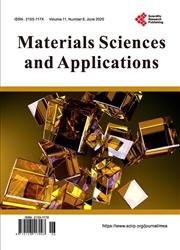Structural and Mechanical Properties of Alumina-Zirconia (ZTA) Composites with Unstabilized Zirconia Modulation
引用次数: 4
Abstract
Zirconia toughened alumina (ZTA) ceramics are very promising materials for structural and biomedical applications due to their high hardness, fracture toughness, strength, corrosion and abrasion resistance and excellent biocompa-tibility. The effect of unstabilized ZrO 2 on the density, fracture toughness, microhardness, flexural strength and microstructure of some Zirconia-toughened alumina (ZTA) samples was investigated in this work. The volume percentage of unstabilized ZrO 2 was varied from 0% - 20% whereas sintering time and sintering temperature were kept constant at 2 hours and 1580˚C. The samples were fabricated from nanometer-sized (α-Al 2 O 3 : 150 nm, monoclinic ZrO 2 : 30 - 60 nm) powder raw materials by the conventional mechanical mixing process. Using a small amount of sintering aid (0.2 wt% MgO) almost 99.2% of theoretical density, 8.54 MPam ½ fracture toughness, 17.35 GPa Vickers microhardness and 495.67 MPa flexural strength were found. It was observed that the maximum flexural strength and fracture toughness was obtained for 10 vol% monoclinic ZrO 2 but maximum Vickers microhardness was achieved for 5 vol% ZrO 2 although the maximum density was found for 20 vol% ZrO 2 . It is assumed that this was happened due to addition of denser component, phase transformation of monoclinic ZrO 2 and the changes of grain size of α-Al 2 O 3 and ZrO 2不稳定氧化锆调制下氧化铝-氧化锆复合材料的结构和力学性能
氧化锆增韧氧化铝(ZTA)陶瓷具有较高的硬度、断裂韧性、强度、耐腐蚀和耐磨性以及优异的生物相容性,是一种非常有前景的结构和生物医学应用材料。研究了不稳定zro2对氧化锆增韧氧化铝(ZTA)试样的密度、断裂韧性、显微硬度、抗弯强度和显微组织的影响。在烧结时间为2 h,烧结温度为1580℃的条件下,不稳定ZrO体积率为0% ~ 20%。以纳米级(α-Al 2o3: 150 nm,单斜ZrO: 30 ~ 60 nm)粉体为原料,采用常规机械搅拌法制备了样品。使用少量助烧剂(0.2 wt% MgO),试样的理论密度达到99.2%,断裂韧性为8.54 MPam½,维氏显微硬度为17.35 GPa,抗弯强度为495.67 MPa。结果表明,单斜ZrO - 2的弯曲强度和断裂韧性在10 vol%时达到最大值,而维氏显微硬度在5 vol% ZrO - 2时达到最大值,而密度在20 vol% ZrO - 2时达到最大值。分析认为,这是由于致密组分的加入、单斜晶zro2的相变以及α-Al 2o3和zro2晶粒尺寸的变化所致
本文章由计算机程序翻译,如有差异,请以英文原文为准。
求助全文
约1分钟内获得全文
求助全文

 求助内容:
求助内容: 应助结果提醒方式:
应助结果提醒方式:


